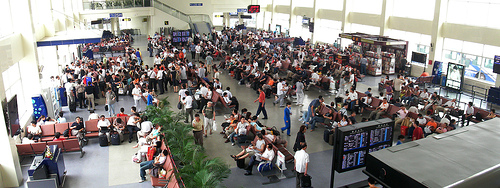
Dear Editor,
We were pleased to see the ‘original article’ by Milne and Shaw (2008) offering advice for those traveling to the Beijing Summer Olympics Games in August later this year in a professional or participatory capacity. The authors are to be complimented on their endeavours to accommodate a comprehensive range of environmental aspects that might influence health and performance. Their experiences in China in particular should be of interest to other groups, especially those hitherto unable to make reconnaissance visits to its competitive venues and training camps to experience and monitor the challenges to be faced.
Besides they are in good time to be of use for devising travel strategies and general advice to be circulated to all athletes selected to participate and their support staff.
There is one area that we would wish to comment on, the issue of travel fatigue and jet-lag. These problems will be worse for European, African and American athletes than for those from Australia and New Zealand in view of the difference in time-zone transitions. Furthermore, some of the advice about dealing with jet-lag should not be based on the previous report of Milne and Fuard (2007) in this journal. The interpretation of anecdotal information, on one individual, was flawed. It is easy to beat an opponent who does not exist and the conditions that provoke jet-lag may not have applied in the trip they described.
In the original report, a brief account was given about one subject who traveled between Europe and New Zealand and back within a few days.
The itinerary focused upon constituted a net zero time-zone transition by which time body-clock time and local time were resynchronised. The root cause of jet-lag is the desynchronisation that occurs between the endogenous circadian rhythm and local environmental time. Prior to undertaking the last trip before the critical final game, the athlete would not have been in France long enough to adjust to European time, is unlikely to have experienced anything more severe than mild jet-lag, even if travel fatigue was severe.
The authors made no attempt to measure jet-lag, either subjectively or by means of an appropriate biological marker. Jet-lag is likely to have been minimal by the time of the criterion match since there would have been limited adjustment before the last 12-hour time-zone transition and hence no need of a further re-adjustment. Besides, there was no valid measure of performance used. Evidence consists of an anecdotal comment that the player’s performance was up to its usual high standard (open skills) and that he kicked a conversion and three penalty kicks (closed skills). Finally, the cocktail of soporifics that were advocated are not recommended as a panacea for jet-lag in recent reviews (Waterhouse et al., 2007) or in consensus statements about alleviating jet-lag (Reilly et al., 2007a).
Lastly, the notes about travellers’ diarrhoea and on food are to be welcomed. Whilst the notes are necessarily brief, an appropriate further reference would be that of Reilly et al. (2007b). In this consensus, supported by the International Association of Athletics Federations, more detailed advice on food and nutrition is given, as is an account of other gastrointestinal problems that traveling athletes face.
By:
Reilly, Thomas; Atkinson, Greg; Edwards, Ben; Waterhouse, Jim
Chronobiology Research Group
Research Institute for Sport and Exercise Sciences
Liverpool John Moores University
References
Milne C. Fuard MH. Beating jet lag. Br J Sports Med 2007; 41: 401.
Milne CJ. Shaw MTM. Travelling to China for the Beijing 2008 Olympic Games. Br J Sports Med 2008; 42: 321-326.
Reilly T. Atkinson G. Edwards B. et al. Coping with jet lag: a Position Statement for the European College of Sport Science . Europ J Sport Sci 2007a; 7: 1-7.
Reilly T. Waterhouse J. Burke LM. Alonso JM. Nutrition for travel. J Sports Sci 2007b; 25: S125-134.
Waterhouse J. Reilly T. Atkinson G. Edwards B. Jet lag: trends and coping strategies. The Lancet; 2007; 369: 1117-1129.